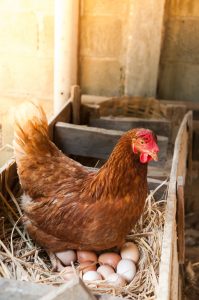Broody Hens – When such sweet little ladies turn into complete fire-breathing dragons in a snap. When it happens … you’ll be left with so many questions and I’m here to help answer some of the most common! Let’s waste NO time and jump right in!
What is a broody hen? — The answer is a broody hen is a chicken that’s natural maternal instinct has kicked in and she has decided to sit on/hatch a clutch of eggs – these eggs are not always her own. If you have a rooster, sometimes the eggs are fertilized, but they won’t always be. They will sit on the eggs 24/7 only leaving the nest once a day to eat, drink, and poop.
Signs your hen is going broody – The signs are quite obvious in my opinion. When your hen starts to refuse to leave the nesting box, when they puff up, become agitated, and try to bite you when you are near her nest (hence the fire-breathing dragon comment), when she is not coming out to eat or drink, and she has plucked all the feathers from her belly and chest — All these are telltale signs that your hen has gone broody or “to the dark side” as I like to say.
How to care for a broody hen – when caring for a broody hen, try to offer her food and water at least once a day. Sometimes she’ll accept your offer and sometimes she’ll be uninterested. Both are okay! Just make sure it is easily accessible to her. If she does not get out of the box some days, this is normal. Sometimes they’ll go days without leaving the nest. Make sure you provide her with a safe and clean place to sit on her eggs, a nesting box is ideal in this situation. Try your best not to touch or move the eggs if possible. When it comes to your broody hens it is best to let her do her thing! Being their instinct, hens know exactly what to do for their babies. Let her be the expert and only intervein if you see a serious problem.

She’s become broody… Now what? – well you have a few options here:
Option A.) Don’t let her stay broody for long. If you notice signs of broodiness, try to pull her out of it as quick as you can. If she is dead set on sitting on the eggs, try to remove her from the box and make sure there are no eggs for her to sit on. Often times removing her from the box is not enough. When a hen is trying to hatch eggs, her belly becomes very warm so, placing her in an area that will help cool her belly can help change their mind about laying on the eggs. I personally avoid ice baths and like to place the hen in an elevated, wire cage, so that a breeze can get to the belly and help cool it gradually.
Option B.) Let her run her course. When doing this, make sure you have set your hen up so she has the best chance at hatching those chicks. Moving the hen and her eggs into a crate of some sort that will allow her to keep her eggs safe is a great option. Keep this crate in the coop, so the hen is still around her flock. This also makes re-integrating the hen and new chicks with the flock much easier. If you choose to move her to her own crate, ensure that she has access to fresh food and water at all times – this is crucial.
Personally, I have only used Option A – with a flock of 70 I need NO MORE chickens! I’m at max capacity.
Hopefully, I’ve answered some of your questions by this point, if you’ve got any more feel free to ask! Just keep in mind, whether you decide you’re ready for chicks or want to boot the hen off the nest, you need to do what best fits your situation and lifestyle! No one knows the best choice for your flock better than you!